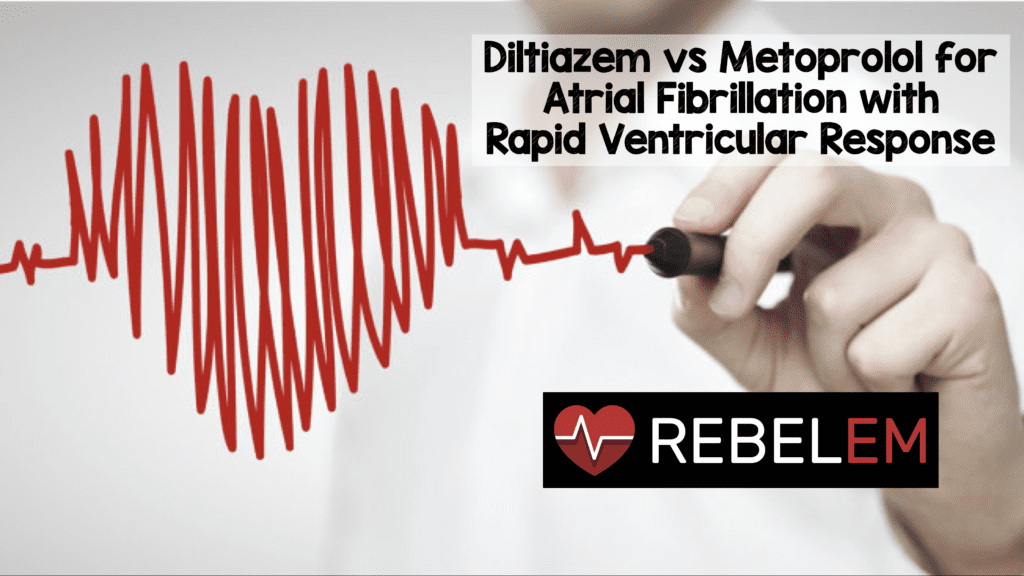
 Background: Atrial fibrillation (AF) is a commonly encountered dysrhythmia in the Emergency Department (ED). Atrial flutter is less common but its management is very similar to that of AF. In patients with chronic AF or unknown time of onset and a rapid ventricular response (RVR), rate control and consideration and initiation of anticoagulation therapy are the standard ED approach. Both beta-blockers and calcium channel blockers are commonly used for rate control in the ED but it is unclear whether one of these agents is superior to the other as there is scant high-quality data on the topic (Demircan 2005).
Background: Atrial fibrillation (AF) is a commonly encountered dysrhythmia in the Emergency Department (ED). Atrial flutter is less common but its management is very similar to that of AF. In patients with chronic AF or unknown time of onset and a rapid ventricular response (RVR), rate control and consideration and initiation of anticoagulation therapy are the standard ED approach. Both beta-blockers and calcium channel blockers are commonly used for rate control in the ED but it is unclear whether one of these agents is superior to the other as there is scant high-quality data on the topic (Demircan 2005).
Clinical Question: Is diltiazem or metroprolol the more effective agent for rate control in AF with RVR in the ED?
Article: Fromm C et al. Diltiazem vs. metoprolol in the management of atrial fibrillation or flutter with rapid ventricular rate in the emergency department. J Emerg Med 2015. PMID: 25913166
Population: Adult patients > 18 years presenting with atrial fibrillation or atrial flutter.
Intervention: Diltiazem 0.25 mg/kg (max dose of 30 mg) or metoprolol 0.15 mg/kg (max dose of 10 mg) IV
Control: None
Outcome
- Primary: Heart Rate < 100 beats per minute (bpm) within 30 minutes of drug administration
- Secondary: SBP, DBP and Heart Rate at 0, 5, 10, 15, 20, 25 and 30 minutes
Design: Prospective, randomized, non-inferiority, double-blind study
Excluded:
- Atrial rate < 120 bpm or > 220 bpm
- SBP < 90 mm Hg
- 2nd or 3rd degree AV block
- Temperature > 38oC
- Acute STEMI
- Known NYHA Class IV heart failure
- Chronic COPD
- Prehospital administration of any AV nodal blocking agent
- History of allergic reaction to diltiazem or metoprolol
- History of sick sinus or pre-excitation syndrome
- History of anemia
- Pregnancy or breastfeeding
- Cocaine/methamphetamine use within 24 hours
Primary Results
- 54 patients met inclusion criteria (diltiazem n = 25, metoprolol n = 29)
- 52 patients included in analysis (1 excluded post-randomization from each intervention group)
Critical Findings
-
Primary Outcome (HR < 100 bpm at 30 min)
- Diltiazem group 95.8% vs. Metoprolol group 46.4% (p < 0.0001)
- Diltiazem had more rapid rate control than metoprolol at every time interval measured
- No difference in bradycardia events or hypotension events between groups
Strengths:
- Although small, this is the largest RDCT comparing diltiazem versus metoprolol head to head
- Randomization and blinding were well done
Limitations:
- Convenience sample of patients
- Group initially calculated an n = 200 patients to achieve 80% power to detect noninferiority. However, they only collected 52 patients due to early stoppage based on the degree of benefit. It is possible that the results would have regressed to the mean if full enrollment was pursued.
Other Issues:
- About 20% of patients in both groups received adenosine at some point
Authors Conclusions: “Diltiazem was more effective in achieving rate control in ED patients with AFF and did so with no increased incidence of adverse effects.”
Our Conclusions: Diltiazem is non-inferior to metoprolol for rapid rate control in patients with AF and RVR. Larger, multicenter RDCTs are needed.
Potential to Impact Current Practice: This study helps to defend what is the most common practice in the ED for patients with AF and RVR who require rate control.
Bottom Line: The best available evidence demonstrates that diltiazem achieves rate control faster than metoprolol in patients with AF and RVR. Diltiazem should be considered the first line agent.
Read More
- ALiEM: Atrial Fibrillation Rate Control in the ED: Calcium Channel Blockers or Beta Blockers.
- ALiEM: Beta Blockers Vs. Calcium Channel Blockers for Atrial Fibrillation Rate Control: Thinking Beyond the ED.
- TheSGEM: SGEM#133 – Just Beat It (Atrial Fibrillation) with Diltiazem or Metoprolol?
References
- Demircan C et al. Comparison of the effectiveness of intravenous diltiazem and metoprolol in the management of rapid ventricular rate in atrial fibrillation. Emerg Med J 2005;22:411–4. PMID: 15911947
Post Peer Reviewed By: Salim Rezaie (Twitter: @srrezaie)
The post Journal Update – Beta Blocker vs. Calcium Channel Blocker for Rate Control in Atrial Fibrillation appeared first on REBEL EM - Emergency Medicine Blog.
